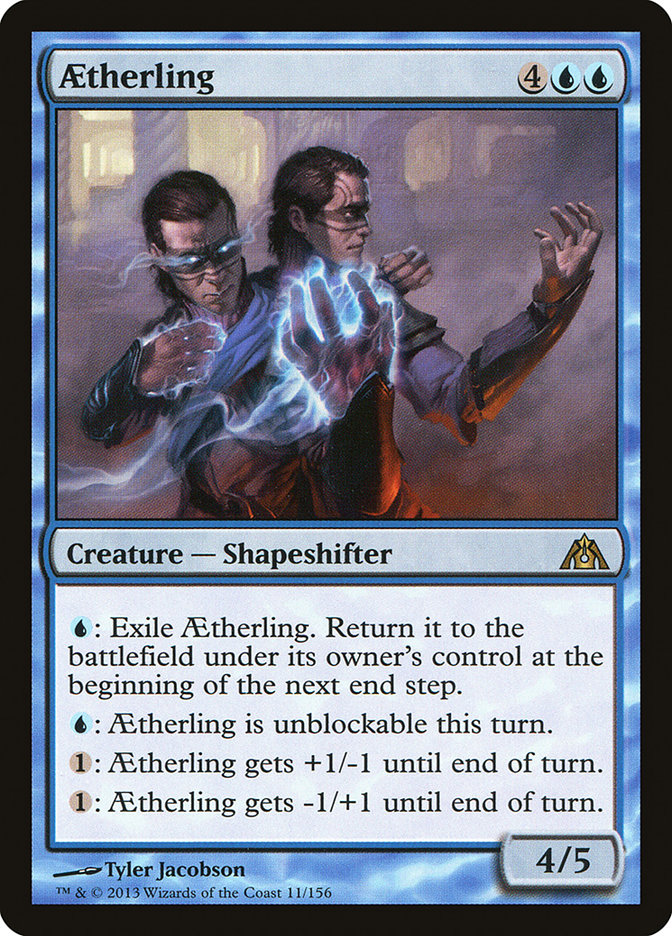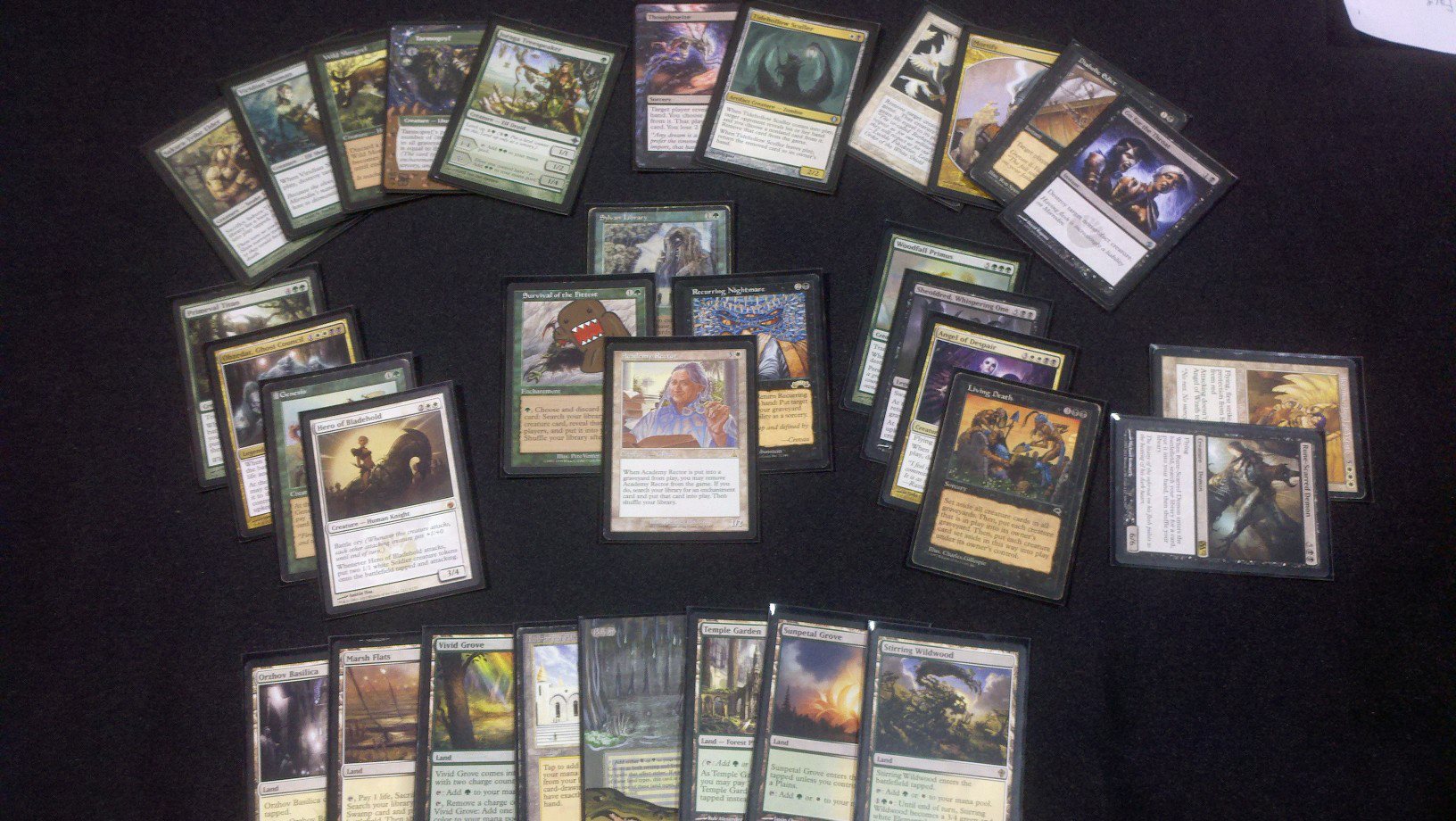Dead wrong. Wrong wrong wrong.
Welcome to a mistake-free another edition of Cubers Anonymous.
Mistakes are a Cube owner’s best friend. Making mistakes seems counterintuitive for anything considering that people don’t like to be wrong (myself included), and mistakes while Cube building are often considered a waste of time. I disagree! Which is good, since I’ve made many, many mistakes in the five years since I first started building my Cube.
Regarding Aetherling, it’s not the first time I’ve been wrong in my initial review of a card—just the most recent. I won’t dive into my incorrect analysis on Aetherling from my last article since you can just click the link and see for yourself. I was dead wrong in my prediction, and it took me all of one time playing with Aetherling in Cube a couple weeks after to easily see that. I made one of the easiest mistakes to make when thinking about a new card, and that was shoehorning it into the same group as an older card. In this case I thought Aetherling was Morphling all over again. I didn’t account for the extremely relevant +1/+2 to its stats, the fact that there will never be chump blocking to aid those stats, and the fact that you CANNOT KILL THIS CREATURE. A terrible whiff by me.
Before we dive deeper into this article, I want to share two quotes that you should keep in mind while reading:
If you aren’t willing to learn from and admit to prior mistakes, you aren’t actually improving your skills; you’re just keeping up.
Experience is the name everyone gives to their mistakes.
The second quote is a famous one attributed to Oscar Wilde, a European playwright from the late 1800s. It’s one of my favorite quotes and is especially relevant for this article. The first quote is from none other than Usman Jamil! When Usman posted this as a tweet earlier this year, I immediately favorited it. It’s one of the cleanest cut and truest statements regarding Cube I’ve ever read, not to mention it prompted me to write this entire article based on the inspiration.
Why don’t we look at some common mistakes made by Cube owners?
Common Mistake #1: Fearing Proxies
I often hear from new or potential Cube owners "I can’t wait to play with my Cube once I get all the cards for it!" Can’t wait? Don’t wait! Spend a few dollars and a few hours of your time to go down to your local Kinko’s store and print out some proxies of the cards you don’t yet own for your Cube. This accomplishes two things: you can now play with your new Cube functionally even though it won’t be pretty yet and you can figure out which cards need to be replaced without spending extra money on cards you ultimately don’t need. This is especially important for new cards, which I’ll get to in a bit.
Saving money on unnecessary cards allows you to spend that money or save those trades for making your Cube look great with foils, alters, and foreign cards. "Pimping" your Cube is a time-honored tradition, so don’t be afraid of proxying a new card to your Cube until it’s earned its slot.
Common Mistake #2: Only Adding New Cards
Just like a Constructed format, oftentimes when a new set is released and new cards are put into the format’s card pool, new cards for a Cube can make older cards more relevant. Sometimes this is easy to spot (Stoneforge Mystic); other times it takes a little digging (landfall creatures? Undiscovered Paradise!). Not only is it important to add older cards to help boost newer cards, but it’s important to go back and try older cards that you’ve tried in the past that may need another shot or to rearrange a potential archetype or color identity.
When I was reconfiguring my black section last year, I added between fifteen and twenty old cards per try attempting to find the best configuration. Magic often has the answer card you’re looking for in its deep history; you just have to poke around a little to figure it out! I’m about to reconfigure my black section once again and will be trying a bunch of older cards to spice it up.
Common Mistake #3: Sticking to Your Initial Evaluations
Notice above when I was talking about Aetherling how I said that I realized this in a Cube match. Well, after my review, I proxied it up and tried it out anyway. Even though I dogged it in my article, I proxied it up to try it out anyway. Looking back at Usman’s quote from above, I think this is the most common and easiest mistake to fix. Admitting you’re wrong in Cube evaluations should be easy since all it does it enhance the Cube experience for you and your drafters. This is a case where no one cares about what you thought incorrectly in the past as long as you come around and right your wrong. I find it hard to believe that anyone drafting my Cube would care one bit that I was wrong about Aetherling or any other sweet card as long as it’s in my Cube and they can play with it anyway.
If I were to hold tight to my initial reactions, my Cube would probably be crappy since I tend to be wrong a decent amount of time. Unless I’m talking about Blood Scrivener—then I happen to be right. [Editor’s Note: *sigh* You win this one, Mr. Parnell.] Here is a short list of cards I was wrong about right out of the gate but came around to and are now powerhouses in my Cube:
Consecrated Sphinx
Elesh Norn, Grand Cenobite
Sphinx’s Revelation
Entreat the Angels
If you don’t admit you’re wrong when you make these mistakes, your Cube will become stagnant, and you’ll be way behind the curve on sweet, fun cards. Most Cube owners come around to awesome cards eventually, but when you decide to not try things because you want to hold on to your word, you become the only one that misses out.
My way of testing cards for the last year or so has been to make two waves of changes. I usually update my Cube with around ten cards four times a year and then update my Cube with twenty or more cards another four times a year. This doesn’t include small changes of two or three cards that I make monthly, but the two larger sweeping changes are more important.
The first large change comes whenever a set is released. I compile a list of new cards I know are going to be good, a list of old and new cards I’d like to try to change a subsection of my Cube, and a list of new cards that I’m not sure about. Once I have this list, I separate the cards into two lists/waves; the first has two-thirds of the cards, and the second has one-third of the cards.
The first larger list is the one I immediately put into my Cube for testing. This is often compiled of new cards I’m pretty sure about and old cards that are going in to help an existing Cube section. I make sure to seed these cards into packs for the first month to see them perform and then not seed them for the rest of the time all while watching to see how they’ve assimilated to the environment. In this first wave, no card gets less than three months to have a shot at staying in the Cube—I don’t feel you can get an honest read on a card that you like in less time than that.
The second wave comes around two months after the first larger wave. This is compiled of new cards I wasn’t sure about and older cards getting a second chance. This is also the wave the cards go in that other people in the community have suggested that I was low on or didn’t consider initially. I again seed these cards for about a month and watch them closely as I did the first wave. This second wave doesn’t get the three-month grace period, however; they get four weeks or so to show their stuff or back on to the waiting list they go.
This method helps fix any evaluation mistakes I’ve made over a three months period, ensuring that is the longest I go without having the most relevant new cards in my Cube is three months. Usually at the end of that period a new set is ready to come out, and we start the process again!
A great tool to assist you in part of this process is what you’ve likely heard other Cubers like Usman, Anthony Avitollo, and Matt Kranstuber talk about: the on-deck binder. This is a collection of cards that have left your Cube after being in it, cards that you consider on the fence for Cube inclusion, or new cards that you have yet to try. This is the easiest way to help with ideas for updating your Cube since you are able to save past, present, and future ideas all in the same place. This doesn’t have to even be a binder per se, just a list of cards that meet those criteria will usually do. If you do have a binder and want to include cards you don’t yet own in it, print out a proxy and slot it in so you can flip through and look at everything easily.
The most important thing to know and remember in Cube building is that your Cube will never be perfect even though you’ll always want it to be. There will always be cards that are missing that could make your Cube better and cards in your Cube that have overstayed their usefulness. Your Cube is your own specific metagame, so change it up every now and then! Don’t become a slave to old ideas just because that’s what everyone else is doing or you feel like you have to take out a card that should remain in your Cube.
Try new cards. It’s great to make mistakes as long as you admit that they are! It’s much tougher to learn and grow if you think you’re just keeping up and are scared to try things that no one else has done yet. No cards are sacred, so allow yourself and your Cube to grow by cutting some "Cube staples." You can’t become a more experienced Cube builder without making a bunch of mistakes along the way!
Thanks for reading everyone; I’d love to hear some stories about how mistakes you made helped you improve your Cube! Also, make sure to check out a great new Cube forum called RiptideLab.com. It’s operated by Cube writer Jason Waddell and is just starting to pick up steam as a great place to talk Cube exclusively. There are also a handful of articles there, so go check it out!
As always, this week’s sweet deck.
The only mistakes made during this draft were by the person on my left. Thanks, Chris Yarbrough! Drafted at GP Providence with Ryan McKinney’s Cube!
@JParnell1 on Twitter
Official Facebook Cube Drafting Page


